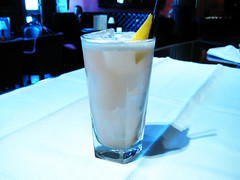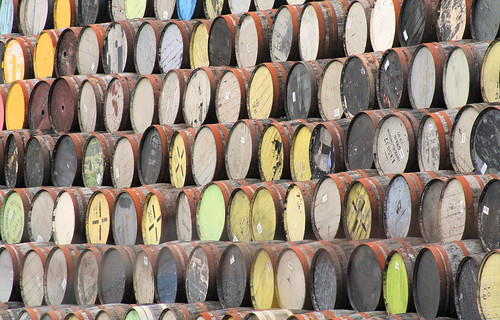Forty Five & Forty Six: on tour
In which the Company goes a'travelling.
Read MoreNew Zealand. The land of the long white cloud, famed throughout the world for its zeals and their newness, and if there's any justice in the world, 42 Below Vodka: the world's most awarded vodka, according to, uh, 42 Below Vodka and hosts of the annual Cocktail World Cup.
The Cocktail World Cup. An annual cocktail competition open to bartenders all over the world which may or may not involve shaking a cocktail while being thrown off a bridge.
In fairness, they tie you to the bridge first. Apparently.

Entries have been open for next year's CWC since early July and the ednbrg inbox is appropriately full of reminders from both 42 Below and their corporate overlords at Bacardi, given that they close at the end of the month. The competition follows the now standard write-in/regional/national/global format, but is seemingly a little less restrictive in terms of ingredients. A lot of competitions specify a maximum number of ingredients or restrict brand usage, but the CWC seems to only request that drinks are made with 42 Below or one of their flavoured vodkas. While the Manuka Honey, Kiwi and Passionfruit vodkas are all pretty awesome, I opted to use the Feijoa, mainly because I like making my life difficult.
Feijoa is a fruit that is firmly planted in the exotic category. It has been adopted as New Zealand's national fruit (originating from South America and named for a Portuguese explorer), looks something like a lime and tastes something like root beer. It's a divisive flavour, like Marmite or Vegemite or anything else that ends in -mite. As for the vodka, it's all eucalyptus and menthol on the nose, with rich herbal flavours and a smooth mouthfeel. If you've never tried it, it's probably worth doing at least once.
Anyway, this one's in the electronic post to the Vodka University.
A walk in the clouds
60ml 42 Below Feijoa
1 barspoon Acacia honey
15ml lemon juice
An eighth of a Galia melon, diced
A third of an avocado, diced
10ml sparkling water
Muddle the diced avocado with the sparkling water in the base of a shaker tin until it forms a smooth paste. Muddle the diced melon with the vodka, honey and lemon juice in the base of a mixing glass. Add this to the puréed avocado and shake with ice. Fine-strain into a chilled coupette and garnish with a melon ball on a cocktail stick with a spear of spring onion.
We are on the edge of a great moment in British history. We are in sight of the point at which the great British public see tequila as something other than a shot or a frozen margarita. My friends, the road to that point will be long and hard, but with courage, strength and resolve, we can make this dream our new reality.
Reina Amargo
50ml José Cuervo Tradicional
25ml lime juice
1 barspoon Campari
2 barspoons honey
Shake all ingredients with ice and fine-strain into chilled martini glass.
Eagle-eyed readers may have noticed that a lot of the recipes I post use honey as a sweetening agent in cocktails. It has become something of a hallmark of my recipes, like the guy who always uses sherbet in his drinks, or the guy who can't not use a foam. One of the things I love about honey is its versatility. As with anything, different kinds of honey have different characteristics, from lighter varieties such as Acacia through to darker, more pungently flavoured ones like Manuka. Choosing the right one to complement the other flavours in a drink can be tougher than you think it's going to be.
Honey also has a great heritage - it is, after all, the original sweetener. In Europe, man was using honey to add flavour to food and drink long before sugar cane was discovered. Since then, sugar spread like wildfire, inspiring creativity, commerce - not to mention war, slavery and cruelty on an industrial scale. Honey, on the other hand, stayed sweet.

Abelinha
50ml Cachaca
1 barspoon honey (works better with a lighter variety)
25ml pink grapefruit juice
25ml cranberry juice
25ml pineapple juice
Shake all ingredients with ice and strain into an ice-filled highball. Garnish with a long grapefruit zest.

This month's Mixology Monday is worried. It worries about its job, its mortgage and, above all, it worries about its future. It's not easy being the internet's premier monthly mixological get-together, but this month's theme proposed by Matt at Rowley's Whiskey Forge could give it a few tips for getting through the crunch. Drinking has seen of tough times before, of course. If outright prohibition couldn't kill hard spirits, then lacking a bit of cash won't either. However, to my mind, when money gets tight it's the fancy imported stuff that ends up first in the firing line and you aim to make do with what's local. Luckily, this means I get to play with Scotch whisky.

(Whisky Galore! by foxypar4, licenced under Creative Commons.)
Much like the global economy, Scotch hasn't had the best of luck over the past few years. 2008 saw blended Scotch overtaken by vodka in UK off-licence (liquor store) sales for the first time and while the category as a whole is still ahead, it seems likely to be caught within the year. But - unlike the economy - some green shoots can be seen, with Diageo building Scotland's first new whisky distillery in 30 years and Glenmorangie investing £45m in new headquarters and bottling site in the Central Belt. Looking back, whisky producers haven't always been that keen on contributing to the economy anyway. As tradition would have it, distilleries were often established in inaccessible glens to confound excisemen sent to tax the stills.

One of the great strengths of a good blended Scotch is its versatility. Quality brands will mix well with dark fruit flavours and heavier notes, but they'll also play with lighter herbal, more aromatic tastes. One thing you can guarantee is that is price will be roughly proportionate to malt content. Dropping less cash will net you a higher percentage of grain whisky in the blend; these will tend toward younger, less flavourful whiskies column-distilled from mixed grains. If economics demand that you stick to a budget, there are gems to be found - Bailie Nicol Jarvie and Black Bottle spring immediately to mind - but if you're planning on spending less than $20/£12 on a blended Scotch, you may be better off pouring some vodka into a barrel and leaving it in the garage for a couple of years.
There's another quality of Scotch that makes it perfect for post-austerity drinking: you don't need to mix it with anything. Sure, you can use it in cocktails and the like, but there's many a purist who will tell anyone with ears that adding anything other than water - maybe, just maybe an ice cube or two, possibly - is heresy of the first order. That said, it feels a little too much like cheating not to include a recipe beyond a Scotch on the rocks. Of course, given no-one anywhere has any money, it would seem foolish to start throwing starfruit and other exotica into a shaker. This month, we're keeping it simple and local. And cheap, hopefully.

Highland Bramble
45ml blended Scotch whisky
30ml freshly squeezed lemon juice
1 barspoon honey
1 dash egg white (optional, I just like the look and the texture)
15ml Crème de Mure
Shake the first four ingredients with ice. Strain into an ice-filled old-fashioned glass and drizzle the Crème de Mure over the top. Garnish with a handful of blackberries and/or raspberries.